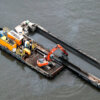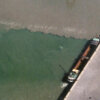Coral reefs are valuable and sensitive natural assets that require special attention when dredging operations are planned.
Natural protection
These reefs act as natural barriers, mitigating the action of ocean waves and erosion which threaten beaches, cities and communities on the water. When coral reefs are unhealthy or damaged, beaches and coastal infrastructure become vulnerable to storms, tsunamis and the increased waves and tides. Climate change will increase these threats, which has also increased the awareness of the value that coral reefs play in coastal protection.
What are coral reefs?
Coral reefs are large, long-living bio-geological formations that include all associated plants and animals. The reefs are marine ridges or mounds formed from the deposition of calcium carbonate by living organisms. They include predominantly hard corals, but also by other organisms such as coralline algae, seaweed and shellfish.
Corals exist in various climates both warm and cold and represent a variety of species, some of which have symbiotic relationships with algae. This makes them dependent on sunlight as well as on filter feeding to meet their energy requirements.
Different forms and species have different characteristics which affect where the corals are found, how they react differently to stress which, also affects how fast they grow. Although coral reefs are robust and have often withstood the forces of storms, climatic change, sea level change and predators, the living elements are just a very thin veneer of delicate tissue, highly sensitive to the surrounding environment.
Dredging & coral reefs
Development to accommodate growing populations along coasts puts stress on coral reefs. Many coral reefs have already been lost to urbanisation. Consequently, the dredging industry has invested in extensive research to manage operations to limit or avoid impacting coral reefs. Hard coral species respond in a variety of ways, e.g.:
- Branching corals, which usually grow vertically, tend to be sensitive to turbidity, but tolerant to sedimentation.
- Plate corals, which usually grow horizontally tend to be sensitive to sedimentation but tolerate turbidity.
- Some coral species are able to change or adapt their growth form or actively remove sediments from their tissue by producing mucous or by tenticular or ciliary action.
Solutions
A number of management solutions can limit damage to coral reefs:
- Obtaining relevant and accurate baseline data about the coral reefs in a potential project area is can help ensure the safety of the reefs.
- This information can help make plans that manage turbidity and sedimentation by selecting specific kinds of dredging equipment or finding seasonal windows when dredging is less detrimental.
- Another means of mitigating impacts to sensitive coral reefs is to remove, relocate and replant the coral prior to commencing dredging operations in the area. This can be effective, for instance, when an access channel with coral in the vicinity needs to be deepen.
- Monitoring before, during and after a project near coral reefs can also help quantify risks. Monitoring can confirm or deny that a project is meeting/ has met the agreed levels of impact and that the predictions of impacts during the Environmental Impact Assessment have been accurate.

























